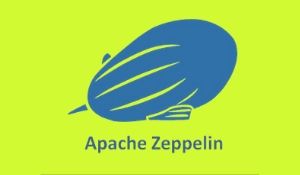
What is Apache Zeppelin?
Apache Zeppelin is an ASCII text file, web-based “notebook” that permits interactive information analytics and cooperative documents. The notebook is integrated with distributed, all-purpose processing systems like Apache Spark (large-scale information processing), Apache Flink (stream process framework), and lots of others. Apache Zeppelin permits you to create lovely, data-driven, interactive documents with SQL, Scala, R, or Python right in your browser.
Explain the Apache Zeppelin Features?
- Interactive Interface
Apache Zeppelin has AN interactive interface that enables you to instantly see the results of your analytics and have an instantaneous reference to your creation:
- Browser Notebooks
Create notebooks that run in your browser (both on your machine and remotely) and experiment with differing types of charts to explore your information sets:
- Integrations
Integrate with various open supplies, massive information tools like Apache comes Spark, Flink, Hive, Ignite, Lens, and Tajo.
- Dynamic Forms
Dynamically produce input forms right in your notebook.
- Collaboration & Sharing
A diverse and spirited developer community provides you access to new information supplies that area unit being perpetually additional and distributed through their open-source Apache two.0 license.
- Interpreter
Apache Zeppelin interpreter idea permits any language/data-processing-backend to be obstructed into Zeppelin. Currently, Apache Zeppelin supports several interpreters like Apache Spark, Python, JDBC, Markdown, and Shell.

How to Add a MySQL Interpreter in Zeppelin?
In the Apache Zeppelin platform, move to the computer menu within the top-right and click on Interpreter:
Here’s wherever you’ll notice a listing of all interpreters. We’d like to form a brand new one for MySQL, therefore click on the produce button within the higher right-hand corner:
Enter a recognizable name for the interpreter (i.e. MySQL) and select cluster as JDBC:
Keep all the default choices, however, enter the specified details and make certain that an association to your MySQL server is established:
We additionally ought to add a custom whole thing to the MySQL connective JAR, therefore, Zeppelin is aware of wherever to execute it from. Transfer the connective, place it within the interpreter/JDBC folder, and so offer the precise path to the artifact:
And that’s it! To check our interpreter, we’d like to form a brand new note. But first, let’s originated our MongoDB interpreter, as well.
Go back to your Interpreter page and click on the produce button. We’re reaching to use this open supply MongoDB interpreter; therefore you will next transfer the .zip file and rename it to .jar.
After that, move to interpreters/, produce a MongoDB/ folder, and paste the .jar into the folder.
You’ll currently have a brand new Interpreter cluster known as MongoDB. move to your Interpreter page, enter a friendly name like MongoDB, and so select MongoDB underneath the Interpreter cluster dropdown.
Now, let’s enter the small print of our newly created ScaleGrid MongoDB cluster in Properties, found within the Overview/Machines section of the Cluster Details page.
How to create a Zeppelin Note?
To run queries that will facilitate visualize our information, we’d like to form notes. From the Zeppelin header pane, click Notebook, and so produce a brand new note:
Make sure the notebook header shows a connected standing as denoted by an inexperienced dot within the top-right corner:
When making a note, you will be conferred with a dialog to enter a lot of info. Select the default interpreter as our newly created MySQL and click on produce Note.
How to Run Queries on the Zeppelin Note?
Before we are able to run any queries, we have a tendency to additionally ought to mention the kind of interpreter we’ll be exploiting for our note. We are able to try this by beginning our note with %mysql. This may tell Zeppelin to expect MySQL queries in this note.
And now, we’re able to question our info. For the aim of this instance, I am going to use my WordPress installation that contains a typical wp_options table to question and visualize its information.
It works! You’ll currently click on the varied charts to check the information in numerous graph formats.
Similarly, for MongoDB, make certain you’ve got information within the MongoDB cluster. You’ll add some by reaching to the Admin tab and running Mongolian monetary unit queries.
Here’s AN example of some MongoDB information within the note:

How to Share Links to Your Notes?
Now that your information is prepared for mental image and querying, you will need to point out it off to your team. You’ll try this terribly simply by making a shareable link to the note:
This shareable link is out there for anyone to look at, and you’ll additionally favor sharing a link to a particular graph only:
What is a zeppelin interpreter?
Zeppelin Interpreter is that the plug-in that changes zeppelin users to use a particular language/data-processing-backend. As an example to use scala code in Zeppelin, you would like a spark interpreter.
When you click on the +Create button within the interpreter page the interpreter drop-down list box can gift all the out there interpreters on your server.
What is the zeppelin interpreter group?
Every Interpreter belongs to AN InterpreterGroup. InterpreterGroup may be a unit of start/stop interpreter. By default, each interpreter belongs to one cluster however the cluster may contain a lot of interpreters. as an example, the spark interpreter cluster embodies spark support, pySpark, SparkSQL, and therefore the dependency loader.
Technically, Zeppelin interpreters from constant cluster area unit running within the same JVM.
Interpreters belong to one type A registered along and every one of their properties area unit listed within the interpreter setting.










